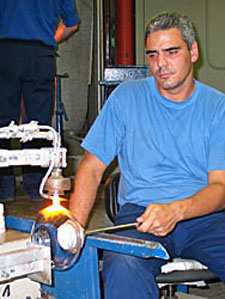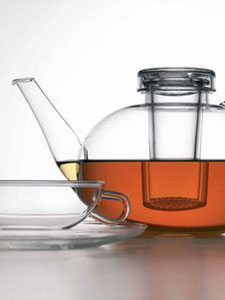Glass Teaware Spotlight: Jenaer Glas


A Story Made of Glass
Jenaer Glas makes among the finest consumer glass items in the world. Its stylish teapots are rightly considered works of art, with some on display in renowned art museums. On a recent trip to Jena, Germany, the university town that the company calls home, I was pleasantly surprised to discover that it has an interesting history that is worth telling. I hope you may agree.
It all began with Otto Schott, a chemist and glass engineer, having the vision of uniform production. In other words, making glass items that would resemble one another. It is easy for us today to forget what a novel notion this was. But at the end of the eighteenth century, with most glass items still created by hand, the quality of output was still a guessing game. Schott was the first to render this an industrial certainty.
And so the Glastechnisches Laboratorium Schott & Gen was born. Production started in 1886. Original products included optical and thermometer glasses. The following year, a crucial discovery was made: borosilicate, a heat and chemically resistant glass. This gave a huge boost to the company's business.
When it came time to celebrate its 25th year anniversary, the company had grown from an experimental glass factory into an internationally renowned manufacturer of optical and industrial glasses. Soon to be added was fiolax, tube-shaped glass used for vials, ampoules and syringes. Allowing the company to play a significant role in supplying Europe's nascent pharmaceutical industry.
For our purposes, the story gets more interesting in 1918, for this is the year that the company begins producing household glass. Preservation jars are first. Quickly followed by tea glasses, feeding bottles, and finally cookware. All bearing the trade name Jenaer Glas.
In the 1930's the company's products were visibly influenced by the design concepts of Bauhaus, an important art movement. It brightest stars all put their stamp on Jenaer products. Perhaps the most famous of these is the teapot created by Wilhelm Wagenfeld. This item, arguably the most stylish teapot ever conceived, continues to be made today.
With the rise of Hitler and his Nationalist Party much of German industry was converted to military use. Jenaer Glas was no exception. The company's glass-making expertise was recruited to help in the war effort. And paid an enormous price for this. The factory was bombed heavily during the war.
Americans were the first to liberate Jena. But the Four Powers pact called for handing the territory over to the Russians in 1945. Prior to leaving what would soon become Eastern Germany, US troops transfer the "brain trust" of Jenaer Glas to the West. Included in the manoeuvre were forty-one of the company's scientists, administrators and their families.
Jenaer Glas would suffer further dismantling under the incoming Soviets. In 1946, Russian troops begin dismantling all the machinery that survived the war for transfer to the Soviet Union. The renowned factory is soon left an empty carcass.
But the Germans persevere in reconstructing much of what was lost. Unfortunately, the repairs are completed just in time for all property to become expropriated by the state. In 1948 the company become a state-owned "property of the people."
Meanwhile the technicians that the US troops transferred to Western Germany build a rival factory in the town of Mainz. And begin production in 1952. Now we have a dilemma. Both companies are calling themselves Jenaer Glaswerk Schott & Gen. So legal actions commence, and the ownership of the Jenaer name remains a point of contention for almost thirty years. Finally, in 1980 the parties resolve their differences. In an agreement that would make Salomon proud, they agree to split the name. The West German company becomes Schott Glaswerk, while the people in Jena shorten their name to Jenaer Glaswerk.
All are happy for the ensuing nine years. When suddenly the Berlin Wall dramatically comes down in 1989. And Germany is united once again. The euphoric reconciliation of the two former rivals leads to renewed talks between the two Glaswerks. And two years later, the company is joined once again.
Much needed funds become available to bring the Jena factory up-to-date, and in 1994 it reopens as one of Europe's most advanced production facilities for manufacturing of kitchen and tableware glass. Its products once again bear the famous name of Jenaer Glas.
Next year, the company will celebrate a ten year anniversary of its rebirth. It has much of which to be proud. In a short span of time, it has managed to leave behind the vestiges of its central-planning past, and become a model of efficiency, innovation, and customer-focus.
For a company that had been at the center of the drama that is 20th Century European history, it is a happy ending indeed.
